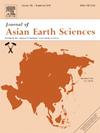Indium mineralization of the Chaganbulagen Ag-Pb-Zn deposit in Inner Mongolia, Northeast China: Evidence from geochemistry of sphalerite and chalcopyrite
IF 2.7
3区 地球科学
Q2 GEOSCIENCES, MULTIDISCIPLINARY
引用次数: 0
Abstract
The Chaganbulagen large Ag![]() Pb
Pb![]() Zn deposit in the southwestern segment of the Derbugan metallogenic belt contains significant indium (In) and cadmium (Cd), though their enrichment mechanisms remain unclear. Field geological investigations and petrographic observations revealed well-developed mineralization zoning. Furthermore, four mineralization stages were identified, comprising four generations of sphalerite (SpI-SpIV) and chalcopyrite (CcpI-CcpIV). LA-ICP-MS analysis shows In and Cd mainly occur in sphalerite via isomorphism, followed by chalcopyrite. Cadmium exhibits consistent enrichment across all mineralization stages, whereas indium displays a marked decline from early-stage (SpI: averaging 656 ppm; CcpI: averaging 270 ppm) to late-stage sulfides (SpIV: averaging 1.15 ppm; CcpIV: averaging 0.36 ppm). This depletion trend correlates with decreasing temperatures (336-208 °C) and diminishing Cu
Zn deposit in the southwestern segment of the Derbugan metallogenic belt contains significant indium (In) and cadmium (Cd), though their enrichment mechanisms remain unclear. Field geological investigations and petrographic observations revealed well-developed mineralization zoning. Furthermore, four mineralization stages were identified, comprising four generations of sphalerite (SpI-SpIV) and chalcopyrite (CcpI-CcpIV). LA-ICP-MS analysis shows In and Cd mainly occur in sphalerite via isomorphism, followed by chalcopyrite. Cadmium exhibits consistent enrichment across all mineralization stages, whereas indium displays a marked decline from early-stage (SpI: averaging 656 ppm; CcpI: averaging 270 ppm) to late-stage sulfides (SpIV: averaging 1.15 ppm; CcpIV: averaging 0.36 ppm). This depletion trend correlates with decreasing temperatures (336-208 °C) and diminishing Cu![]() Fe concentrations in the ore-forming fluids. Spatially, shows two trends in indium distribution: (1) vertical increasing with depth in No. X orebody, and (2) lateral zoning with decreasing In content away from the porphyry Mo (Cu) mineralization, highest in proximal Cu
Fe concentrations in the ore-forming fluids. Spatially, shows two trends in indium distribution: (1) vertical increasing with depth in No. X orebody, and (2) lateral zoning with decreasing In content away from the porphyry Mo (Cu) mineralization, highest in proximal Cu![]() Zn stage sphalerite (up to 1112 ppm at 1.5–3 km), moderate in intermediate Cu
Zn stage sphalerite (up to 1112 ppm at 1.5–3 km), moderate in intermediate Cu![]() Pb
Pb![]() Zn and Pb
Zn and Pb![]() Zn
Zn![]() Ag stages orebodies (up to 76.8 ppm at 3–5.5 km), and negligible in distal Ag stage orebodies (< 5 ppm at 5.5–8 km). Indium in chalcopyrite follows a similar enrichment pattern as in sphalerite. Based on this, the Jia-Cha ore field, centered on the porphyry body within 3 km to the northwest and southeast, and the deeper parts of the field are favorable areas for future indium ore exploration.
Ag stages orebodies (up to 76.8 ppm at 3–5.5 km), and negligible in distal Ag stage orebodies (< 5 ppm at 5.5–8 km). Indium in chalcopyrite follows a similar enrichment pattern as in sphalerite. Based on this, the Jia-Cha ore field, centered on the porphyry body within 3 km to the northwest and southeast, and the deeper parts of the field are favorable areas for future indium ore exploration.
内蒙古察干布拉根银铅锌矿床的铟成矿作用:闪锌矿和黄铜矿地球化学证据
德布干成矿带西南段Chaganbulagen大型AgPbZn矿床中含有大量的铟(in)和镉(Cd),但富集机制尚不清楚。野外地质调查和岩石学观察显示成矿分带发育。确定了4个成矿阶段,包括4代闪锌矿(SpI-SpIV)和黄铜矿(CcpI-CcpIV)。LA-ICP-MS分析表明,In和Cd主要以同晶形式存在于闪锌矿中,其次是黄铜矿。镉在所有矿化阶段都表现出一致的富集,而铟则从早期开始显着下降(SpI:平均656 ppm;CcpI:平均270 ppm)到后期硫化物(SpIV:平均1.15 ppm;CcpIV:平均0.36 ppm)。这种枯竭趋势与成矿流体中温度下降(336 ~ 208℃)和CuFe浓度下降有关。在空间上,铟的分布呈现出两种趋势:(1)纵向随深度增加。(2)远离斑岩Mo (Cu)矿化的横向分带,In含量降低,近段CuZn期闪锌矿最高(1.5 ~ 3 km处达1112 ppm),中段CuPbZn和PbZnAg期矿体中等(3 ~ 5.5 km处达76.8 ppm),远段Ag期矿体可忽略(<;5.5-8公里处5ppm)。铟在黄铜矿中的富集规律与闪锌矿中的富集规律相似。据此认为,以斑岩体为中心的家茶矿田西北、东南3 km范围内及矿区深部是今后找矿的有利区域。
本文章由计算机程序翻译,如有差异,请以英文原文为准。
求助全文
约1分钟内获得全文
求助全文
来源期刊

Journal of Asian Earth Sciences
地学-地球科学综合
CiteScore
5.90
自引率
10.00%
发文量
324
审稿时长
71 days
期刊介绍:
Journal of Asian Earth Sciences has an open access mirror journal Journal of Asian Earth Sciences: X, sharing the same aims and scope, editorial team, submission system and rigorous peer review.
The Journal of Asian Earth Sciences is an international interdisciplinary journal devoted to all aspects of research related to the solid Earth Sciences of Asia. The Journal publishes high quality, peer-reviewed scientific papers on the regional geology, tectonics, geochemistry and geophysics of Asia. It will be devoted primarily to research papers but short communications relating to new developments of broad interest, reviews and book reviews will also be included. Papers must have international appeal and should present work of more than local significance.
The scope includes deep processes of the Asian continent and its adjacent oceans; seismology and earthquakes; orogeny, magmatism, metamorphism and volcanism; growth, deformation and destruction of the Asian crust; crust-mantle interaction; evolution of life (early life, biostratigraphy, biogeography and mass-extinction); fluids, fluxes and reservoirs of mineral and energy resources; surface processes (weathering, erosion, transport and deposition of sediments) and resulting geomorphology; and the response of the Earth to global climate change as viewed within the Asian continent and surrounding oceans.
 求助内容:
求助内容: 应助结果提醒方式:
应助结果提醒方式:


